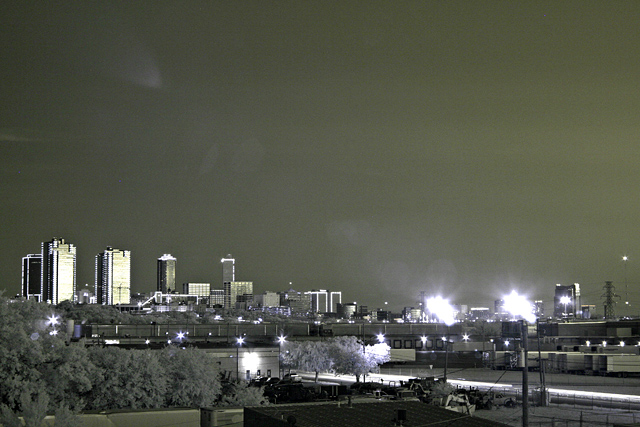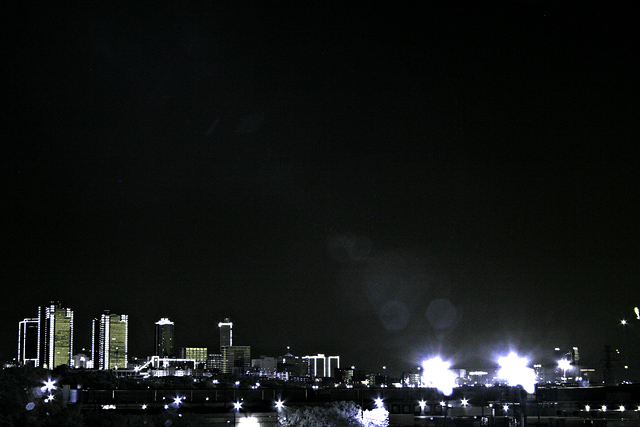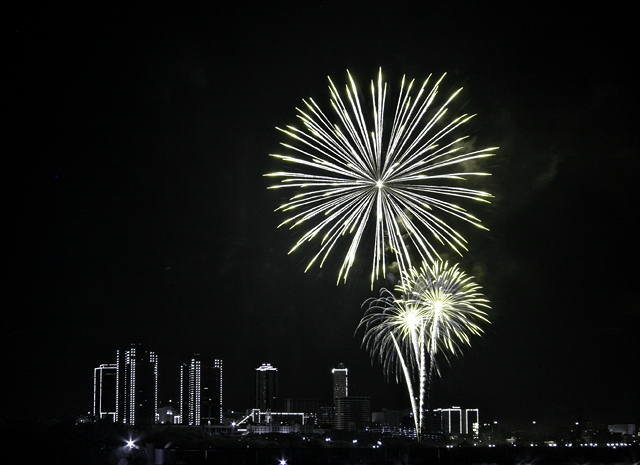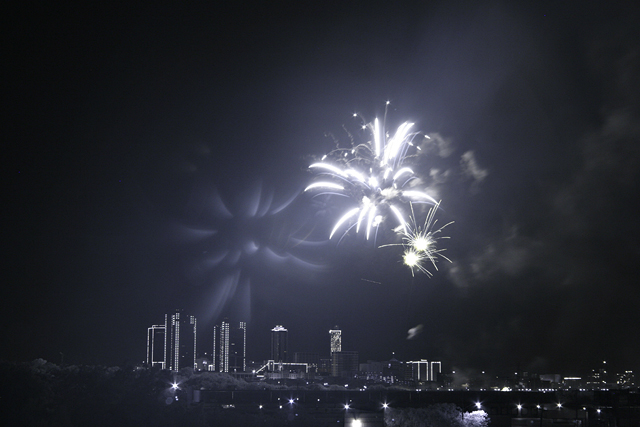IR at Night I say????? Up until now, my mind set for IR Photography has always been that it needed to be done in full sunlight, or if full sunlight was not available, at least done during daylight hours. So, that's all I have ever tried. Conditions for IR have always been pretty much the same, so much so that I hardly ever make any setting changes to my camera for any IR I take.
Recently a whole new opportunity presented itself, being the experimental type that I am, I decided, why not?, go for it! It will either work, or it won't. The camera club that I attend had a group shoot scheduled for night time fireworks. Here in the United States we celebrate our Independance Day on July 4th. This always means many outdoor summer activities, parades, picnics and the like, and always the day is finished up with many, many professional fireworks displays. Naturally that means long exposure shooting from a tripod, and just as naturally, the fireworks being so colorful against the night sky, the photography should be done in Visible Color Light. Well, yes. A natural plan.
I have done a number of Fireworks shoots, always in color, and pretty much have the process down. But, this time when I thought of being with a group of photographers all in the same place, all taking basically identical shots, I just had to be different somehow. I wondered what would happen if I took my photos in IR. Is there even any IR light available at night? We know the sun produces plenty of IR for us, but what's out there at night?
The only light would be man-made since the sun is down. Is there any IR produced by man made lighting, on buildings, or by the Fireworks themselves? Ony one way to find out, just give it a try. If it didn't work out, the other photographers would have plenty of color shots.
Well, I'm happy to report that there is indeed IR light from man made lighting, and it can be captured with a digital camera.
When we all got to the site that was chosen by the club to photograph the Fireworks, I set up my IR modded Canon 350D on my tripod, just as all of the other photographers. I have a remote shutter release, and it was pulled out and set up on the camera. I decided to use my 28-135 IS lens set at a wide angle to capture the Fireworks bursts. I focused on the skyline buildings of Ft Worth, and with the lens basically at infinity, turned off autofocus on the lens. On Manual settings, ISO 400, I decided to try F8 and 4 seconds, as I have had good luck with that in previous years in Visible light. I also decided to try this using the trusty Custom White Balance that I took off green grass, the one I pretty much use for all of my IR work with this camera.
As the sun was setting, I took a few test shots to see what I'd get, and to get my composition and background situated. We knew basically where the bursts would occur from shooting this location in previous years. The Fireworks program was being held at the home field of the Ft Worth Cats, minor league baseball team. This one was taken just as the sun was setting, and still reflecting off the glass of the buildings. The blown out lights on the right hand side that were giving me all that lens flair are from the baseball field. I knew that they would be turned off once the Fireworks started.

Another test shot a bit later as the sun was almost completely down and the sky was turning black. Still a bit of reflection off the towers, and the baseball field lights were really blasting. Still, the skyline was looking good to me. So, the main question was answered, man made lighting does have quite a lot of IR light in it.

So all that remained was to stand around and enjoy the companionship of my fellow photographers while we waited for the Fireworks to begin. Soon enough the baseball game ended and the Fireworks put on quite a spactacular show for us. I didn't change any of my settings during the show, and really did not use any particular skill on my part. I just made as many 4 second exposures as I could, knowing full well that I would have a lot of shots to discard, but conversely, that I would be getting some good ones as I went along.
Here are a few of them with some comments:
The Custom White Balance and the Canon sensor produced the golden, white, and blue colors you see here in the following photos. I chose not to do a lot of post processing to these so that you can see basically what's coming from the camera. These were all shot as JPGs. I have tried some of the more common post processing that is usually done. B&W conversions work very well. False color is out, as there really was no sky color available at night as would be in daytime IR.



I also include a couple of "problem" images so that you know what you may expect if you give this a try. Lens flare on some of the brighter, over-exposed bursts was severe, and gave me some very interesting patterns. The end of the display, or the Finale, is what all Visible light shooters are waiting for, but I was not very successful capturing that part in IR. In color, the different colored bursts differientate themselves, but in IR, with no color definition, it tends to appear as an over-exposed blob of light. Also, just as clouds are very well defined in daylight IR, so is the smoke from the bursts in the air, also contributing to the over-exposed aspect.
The end of the display, or the Finale, is what all Visible light shooters are waiting for, but I was not very successful capturing that part in IR. In color, the different colored bursts differientate themselves, but in IR, with no color definition, it tends to appear as an over-exposed blob of light. Also, just as clouds are very well defined in daylight IR, so is the smoke from the bursts in the air, also contributing to the over-exposed aspect.
Here's a Link to the entire Gallery
Copyright Statement: All images and materials displayed and showcased here, are copyrighted and are the exclusive property of the artist. Images and material may not be reproduced or used in any way without the written consent of the artist.
I hope that this post is helpful, and gives you some new ideas for things you can do in IR. Obviously we are not restricted to shooting only in the daytime. I can't wait to get a chance to do some nighttime shooting, maybe some long exposures of moving objects and light trails. Get out there and give this a try!


5 comments:
There's some very interesting looks there!
I'm curious... in some of the shots where the fireworks clip, would some form of highlight recovery help? Ideally you would do it on a RAW image, though I have a white balance + highlight recovery plugin for Photoshop that might be useful:
http://www.free-photoshop-plugins.com/download-filters/white-balance-plug-in.htm
I'd be curious to see if it might help a little.
Glenn,
Thanks for the comment and the link. I probably was not plain enough, but, I purposely did not do a lot of editing on these images to fix them. I want to present them close to out-of-camera for the reader.
IR images always need post processing and improvements.
Again, thanks for your plug-in link and any help that you give the IR photographer to improve their images.
Best regards,
-=- Jerry -=-
Another IR at night "look" that I've been playing with is IR flash photography. I've got a Vivitar 285HV that's been modified to only emit IR (and a very slight red glow if you're looking straight at it when it fires).
I set it up for taking photos of bands in dark clubs without annoying all the patrons. But I've also been chasing bunny rabbits in my backyard after dark
Been meaning to write up something for you about it, but I first need the time to go out and shoot more photos that way.
I do have a few examples in my flickr stream if you're interested.
Just from fireworks experience it's helpful to remember that shutter speed controls how long the trails extend after a burst and aperture fine-tunes the exposure, especially if you want some other subject to add interest (think audience/family and flash). Fireworks are like sunsets--a nice background.
Opening the shutter after the mortar fires but before the shell bursts makes it easier and has no detrimental effect on exposure, so you can add an extra second of shutter with no penalty.
Since you're already manually focusing at infinity (good call! Airshows also benefit) DOF isn't much of an issue so a wider aperture (F4?) and a shorter shutter like 1.6 to three seconds will give good results.
Personally, I would think it best to drop the iso to 200 or less to go with the wider aperture and use the tungsten WB preset, but these are concepts from full color fireworks shooting so I may be wrong for IR.
We'll see on January 1st?
I love how you chose to be different from the other shooters by going IR, and then sharing results with us.
It's always a delight to go above and beyond pointing and shooting and being disappointed.
Every incadesent light ever made emits IR light - usually as much as visible, sometimes more. Incadesent lights are basically "black body radiation" sources and have a very high output in visible and IR light - out to around 15,000nm, which is where IR light turns into Heat more so than light, which is where the termo-cameras take over (8-14 micron wavelength)
Post a Comment